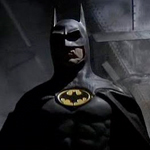 Tim Burton’s BATMAN is a movie about a feeling – a feeling called Batman. It’s a lonely, broken, hanging out in a cave with the bats feeling. A sad about my dead parents but trying to be me feeling. A doing a bad job of passing for a normal person but fuck you I’m gonna dress and drive how I want and do what I want at night feeling. An okay it’s true that I am legitimately crazy and even sometimes hang upside down like a bat when I can’t sleep but does that have to mean I can’t have a girlfriend feeling. The feeling is evoked by shadowy alleys, towering gothic structures (thanks to brilliant production design by FULL METAL JACKET‘s Anton Furst), matte black metal and Danny Elfman’s low, murmuring horns that climb to the rooftops, step to the edge and spread their gargoyle wings in a thunderous explosion of marching drums and rococo instrumentation.
Tim Burton’s BATMAN is a movie about a feeling – a feeling called Batman. It’s a lonely, broken, hanging out in a cave with the bats feeling. A sad about my dead parents but trying to be me feeling. A doing a bad job of passing for a normal person but fuck you I’m gonna dress and drive how I want and do what I want at night feeling. An okay it’s true that I am legitimately crazy and even sometimes hang upside down like a bat when I can’t sleep but does that have to mean I can’t have a girlfriend feeling. The feeling is evoked by shadowy alleys, towering gothic structures (thanks to brilliant production design by FULL METAL JACKET‘s Anton Furst), matte black metal and Danny Elfman’s low, murmuring horns that climb to the rooftops, step to the edge and spread their gargoyle wings in a thunderous explosion of marching drums and rococo instrumentation.
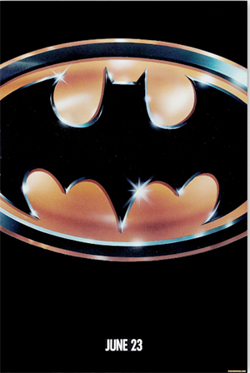 Man, that score. There aren’t many I like better than this one. It’s as eternal as the concept of Batman itself.
Man, that score. There aren’t many I like better than this one. It’s as eternal as the concept of Batman itself.
Now, just as we’re in a groove here – as Batman (in a place that looks sort of like the ’40s, sort of like the ’80s, sort of like a future that never happened) is terrifying muggers, chasing gangsters in fedoras, dodging old timey reporters with similar hats, sitting in his cave looking at scans of old newspaper articles on his computer that looks sturdier than a submarine, or out of costume hiding away in his big empty manor, stewing in a mood that’s black, blue and overcast – here comes this walking splatter of white, green and purple called The Joker. The nerve of this asshole to hold himself as a parallel to Batman! Sure, we understand the need for self expression, the rebellion against conformity, the back and forth between masking and glorying in his disfigurement. And yeah, he knows how to be a funny jerk. His arrogance can be kinda charming. “You look fine.” “I didn’t ask.”
But come on, Joker. Bruce Wayne got this way from having to see his parents die in front of him. You’re the motherfucker who killed them! Even if you weren’t, you’re just another full of shit gangster wearing expensive suits because you bully and ruin people and run crooked businesses. And then you cheat with the boss’s girlfriend and it’s not like you actually care about her. You abuse her. You’re scum.
Even the movie’s famous circular hook – that Joker made Batman by killing his parents and Batman made Joker by knocking Jack Napier into a vat of chemicals – is kind of a lie that the Joker tells himself to feel good. Batman didn’t push him or bump him or chase him. Jack shot at Batman, Batman deflected the bullet and that happened to make Jack stumble over the railing. Batman even tried to catch him. The Joker made himself.
I don’t know where this regular gangster got his cool novelty weapons (electrocuting hand buzzer, acid squirting flower), or his pirate TV equipment, or how just hanging out in a chemical plant gave him the ability to invent a gas that gives people a permanent smile and to taint all of Gotham’s hygiene products with it. But I must’ve seen the movie a dozen times before I even wondered that stuff, because this operates so much on mood and style that standard rules of plausibility seem irrelevant.
Joker declares himself “the world’s first fully functioning homicidal artist.” I don’t care much for his found art (crudely spray painting over paintings hanging in a museum), but the orange and green gas mask he gifts to Vicki Vale is a nice piece of design. For a few movies after this, Burton (who had been hired on the strength of PEE-WEE’S BIG ADVENTURE and greenlit after BEETLEJUICE!) was most passionate about characters who were misfits and artists, and some felt he cared more about Joker than Batman. But the contrast between these two shows that not all weirdos are equal. Both characters are individualists. Only one is an asshole.
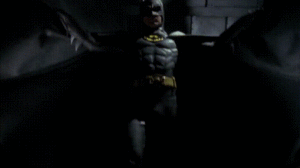 Burton told Cinefantastique‘s Alan Jones in 1989 that Batman “dresses like this for theatrical effect… He dresses up as a bat because he wants to have an amazing visual impact… He’s creating an opera wherever he goes to provoke a strong, larger-than-life reaction. He switches identities to become something else entirely, so why wouldn’t he overdo it?” Maybe you could say the same about the Joker, except he only wants to make an impact to feed his ego. He’s a guy who always travels with an entourage wearing jackets with patches of his face. He’s jealous when he sees Batman in headlines and on TV. He needs everyone to pay attention to him so he pirates the TV signal, gives himself his own show. He turns Gotham’s 200th anniversary celebration into a parade for himself, and against Batman. He lures people to him by throwing them money, which turns out to be a lie.
Burton told Cinefantastique‘s Alan Jones in 1989 that Batman “dresses like this for theatrical effect… He dresses up as a bat because he wants to have an amazing visual impact… He’s creating an opera wherever he goes to provoke a strong, larger-than-life reaction. He switches identities to become something else entirely, so why wouldn’t he overdo it?” Maybe you could say the same about the Joker, except he only wants to make an impact to feed his ego. He’s a guy who always travels with an entourage wearing jackets with patches of his face. He’s jealous when he sees Batman in headlines and on TV. He needs everyone to pay attention to him so he pirates the TV signal, gives himself his own show. He turns Gotham’s 200th anniversary celebration into a parade for himself, and against Batman. He lures people to him by throwing them money, which turns out to be a lie.
BATMAN shows that it’s okay to be a so-called freak if you’re using your power and privilege to help people and to challenge the people who don’t. It’s not okay if you treat others as suckers and opportunities and art supplies. Then it’s just hedonism.
For Bruce Wayne, traditionally at least, hedonism is just a cover story. As played by Michael Keaton he doesn’t really have the billionaire playboy vibe, he seems to be more of a recluse, or kind of a spacey eccentric. His name is famous, but reporters come to his charity event without even knowing what he looks like.
I’ve heard more than one person in recent years say they don’t like the character of Batman because he’s just some super rich guy beating up criminals. It’s true that the concept comes from a different time when a hero inheriting massive wealth was just a good explanation for how he could have lots of equipment and not have to work a day job, and it didn’t need to be considered in any more depth than that. But look at what he does. He’s not trying to be like his parents. Do you think he ever once considered going into medicine like his dad? He seems completely not at home in his own home. He has no interest in rich people shit. Bruce Wayne and the Wayne empire are just a front he has to maintain in order to privately be his true self.
And he’s not some up-from-the-bootstraps libertarian. His goal is to stop other people from having to go through what he did. He doesn’t pull a “I had it tough so stop whining.” He doesn’t even seem vengeful. He uses some humor during his super-heroing, suggesting it can at times be fun for him to do this. And he tries not to let The Joker, who he knows killed his parents, fall off that tower. But the Joker does what he wants.
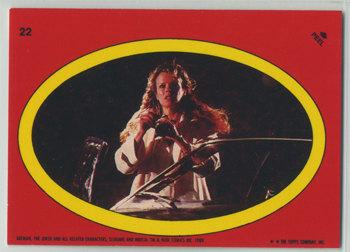
A part of this movie that I always thought was kind of weak was Vicki Vale (Kim Basinger, BLIND DATE). As super hero love interests go, BATMAN RETURNS’s Selina Kyle blew her out of the water. Vicki is more of an ’80s approach to a “strong woman” character – just someone who succeeds in a competitive profession. She’s an accomplished fashion photographer for Vogue, but more proud of her war photos for Time. Sean Young (BLADE RUNNER) had to drop out of the role a week before filming due to a horse riding accident, and I used to think Basinger was comparatively bland. If Batman is such a freak why is he so sprung on a blonde model who looks more like a Bruce Wayne cover story than a soul mate?
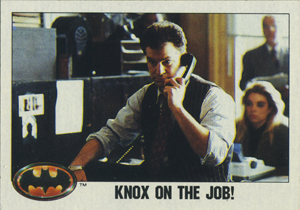
But now I like Vicki. She’s pretty cool. She avoids the easy path and risks her career, teaming with laughing stock Alexander Knox (Robert Wuhl, GOOD MORNING VIETNAM) because she’s intrigued by his claims about a Batman. When she meets Bruce she’s not impressed by the opulence of Wayne Manor – in fact, it’s a turn off. But their date turns into sitting at a regular kitchen table listening to Alfred’s stories.
It’s interesting that even though this was considered the dark, serious version of Batman after Adam West, it’s kind of built on a comical premise: what happens when two people fall for each other, but one of them is Batman? And then he has to rescue her. How many times can he turn his head or stand where the shadows land on his exposed mouth before it starts to seem suspicious?
It’s almost hard to imagine now, but it took the rights holders a decade to get a Batman movie made at all, so it was not considered a sure thing or a probable franchise starter. It finally happened at a time when “there are comic books for adults now!” was considered a novel topic for magazine and newspaper features. In that era it made sense to think you had to riff on the idea of Batman in order to make a Batman movie. And that you’d have to close out the story of The Joker! Those are the types of things that seem dated in this movie, other than the random fucked up part where Bruce pushes Vicki down onto a couch and tells her to shut up.
 By the time the movie did hit it dropped through the skylight smack on top of the zeitgeist. I think it was a perfect storm of timing and marketing. I know I mention this often, but it’s worth repeating: it was absolutely brilliant to sell this movie primarily using the bat-symbol (airbrushed to look three-dimensional, floating on a solid black background, printed on extra glossy paper). The teaser poster had no words other than “JUNE 23”. The final poster added NICHOLSON, KEATON, BATMAN, and the credits, but no pictures of the characters. I read in the book Hit and Run that producer Jon Peters (Barbra Streisand’s hair dresser and boyfriend turned movie producer and studio mogul, now best known for wanting a giant spider in Kevin Smith’s unmade Superman movie) had to pin a guy against a wall and yell at him to get WB to agree to it. (I assume the guy said, “Who– what are you!?”) What a dick, but he was right. This way instead of creating specific expectations for the movie it just drew out people’s own feelings of what Batman meant.
By the time the movie did hit it dropped through the skylight smack on top of the zeitgeist. I think it was a perfect storm of timing and marketing. I know I mention this often, but it’s worth repeating: it was absolutely brilliant to sell this movie primarily using the bat-symbol (airbrushed to look three-dimensional, floating on a solid black background, printed on extra glossy paper). The teaser poster had no words other than “JUNE 23”. The final poster added NICHOLSON, KEATON, BATMAN, and the credits, but no pictures of the characters. I read in the book Hit and Run that producer Jon Peters (Barbra Streisand’s hair dresser and boyfriend turned movie producer and studio mogul, now best known for wanting a giant spider in Kevin Smith’s unmade Superman movie) had to pin a guy against a wall and yell at him to get WB to agree to it. (I assume the guy said, “Who– what are you!?”) What a dick, but he was right. This way instead of creating specific expectations for the movie it just drew out people’s own feelings of what Batman meant.
And, unusual for a comic book character, pretty much everybody had an idea of Batman. I would argue that more elements of Batman are standard issue cultural knowledge than even Superman. People who never in their life opened a comic book were still aware of Batman, Robin, the Joker, Alfred, the Bat Cave, the Batmobile, the Penguin, the Riddler, Catwoman. And likely Bruce Wayne, Commissioner Gordon, Batgirl, Gotham City, the bat signal. Much of this awareness came from the ’60s TV show, which was airing again that summer, drawing both nostalgia and resentment as the “campy” version of a character people wanted to be “dark.” There was lots of hype about Frank Miller’s The Dark Knight Returns (which people usually called The Dark Knight) having revived or reinvented the “darkness” of the character. There were these things now, the magazines said, called “graphic novels.” They’re like comic books only better. Darker.
So there was no need for comic book fans to evangelize. Everybody was already on board. I also remember Batman images having a certain counter-cultural appeal, showing up in catalogs of punk and skate t-shirts. But then the movie came along and the bat symbol was on everyone’s t-shirts and hats. Bootlegs thrived, often doing it wrong, like adding eyes to the symbol! And then the malls started to fill up with Batman everything – often based on the comic book character in general. The movie’s official action figure line was funny in that it re-used an old Joker design but got a likeness of Tracey Walter as “Bob the Goon.” Man, where the fuck is the Alexander Knox figure with reporter’s notebook?
I’m telling you, Batmania was real. Warner Brothers did not open their chain of studio stores until 1991, but they had a glossy mail order catalog which seemed to primarily deal in Looney Tunes and BATMAN merchandise.
These scans are from an all-BATMAN pamphlet version that I must’ve gotten from a movie theater lobby. The models were usually stars of Warner Brothers TV shows or children of executives. The best ever is A NIGHTMARE ON ELM STREET‘s Heather Langenkamp wearing Batman bike gear to promote her sitcom Just the Ten of Us.
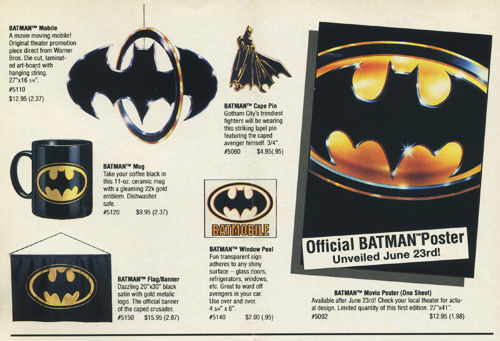
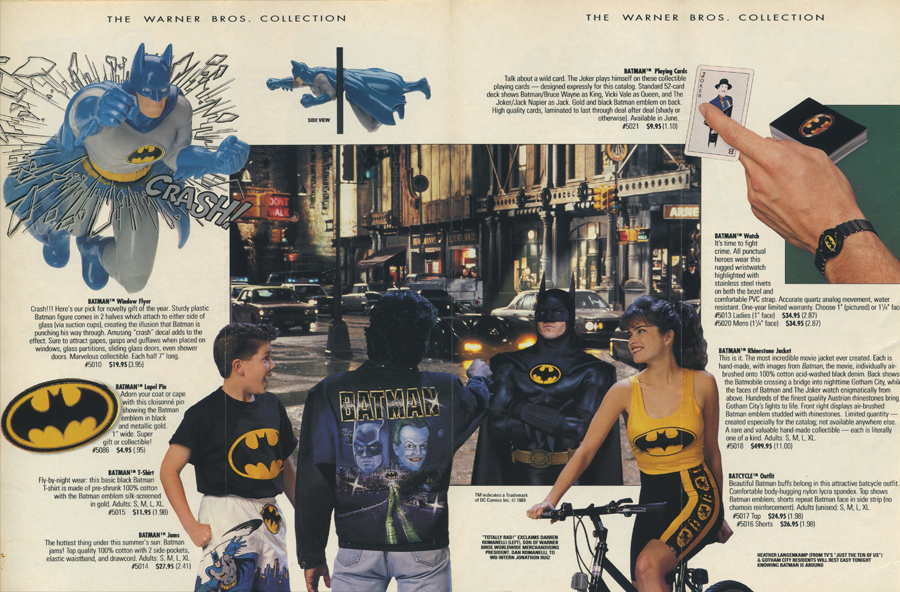
It’s important to mention that there was also BATMAN cereal. And the box just had the bat symbol on it. And it was just slightly sugary corn puffs shaped sort of like the bat symbol. But it was worth purchasing for the Batman bank shrink wrapped to the back of it. And on the back of the bank there was an order form for sending away for a Batman night light.
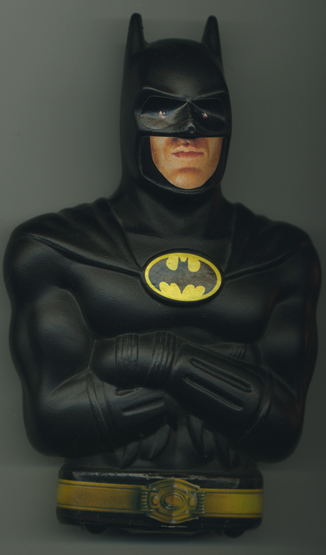
Also, did you know that Batman invented the Taco Bell Cinnamon Twist?
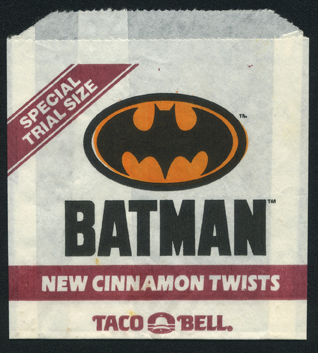
And then of course there were the two albums. The one with just the bat symbol on the cover, which was the Prince songs, and the one with the Batwing levitating in front of the moon, which was the Danny Elfman score. It’s amazing to me that Prince, who I consider the greatest musical artist of my lifetime other than Stevie Wonder, made an entire album for this movie – one sort of in the sample-heavy funk style of the Lovesexy/Black Album era, no less – and it’s not the best part! The songs are all used diegetically, Joker’s henchman playing one on a boombox, for example, or at the parade. This forces me to ask: did The Joker commission Prince to record a theme song for him? That’s what is now known as a “baller move.” And was it Alfred who decided to play Prince for the grey-haired rich people at the Wayne Manor “Save the Festival” party? I’m gonna say it was.
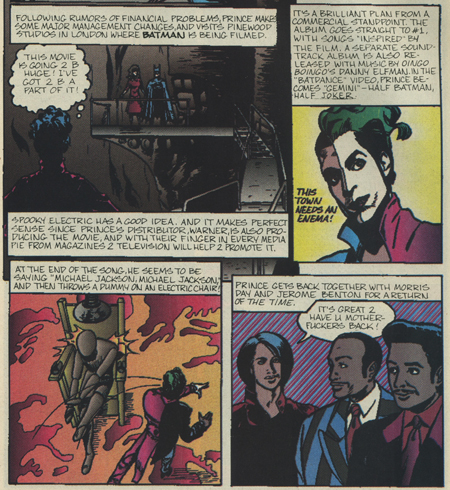
The two songs from the project that I have always loved are not even in the movie. One, obviously, is “Batdance,” sort of a megamix that rollercoasters through bits of the other songs on the album with some crazy guitar and keyboard jamming and sampled dialogue snippets from the movie. The other was the b-side, “200 Balloons,” which seems like it must’ve been intended for the parade scene, but they used “Partyman” instead (my favorite song actually used in the movie) “Trust.” The rest of the album has grown on me over the years, but those two are classics.
Word at the time was that Burton was a Prince fan but was sort of pushed into using the songs, and tried not to put them too upfront. It’s a weird fit, but for me it works. Something about one very distinct artist creating all of the songs makes sense in this world. And they’re only dated if you know Prince eras because there was no one else making music that sounded like that in 1989. Or any other year. Billboard‘s number one song on June 23rd was “I’ll Be Loving You (Forever)” by New Kids On the Block! I think it also works because Prince seemed to be interested in Batman in the same way as Burton. I can’t picture him reading The Killing Joke or having an opinion on the best Robin, but he was fascinated by the idea of Batman’s duality, the imagery of the costumes, the parallels between the hero and the villain, shit like that.
But I guess I just get that from the videos (which I analyzed in this piece, “Batdance: Celebrating 25 Years of Bustin’“), because it’s hard to decipher what, if anything, most of the lyrics have to do with Batman.
Making BATMAN the center of my series on the action movies of ’89 feels weird, because I’ve never thought of it as an action movie. Batman punching guys does not seem to be one of Burton’s interests. On one of the documentaries on the Blu-Ray, Peters-Guber VP of Production Michael Besman says of producer Peters, “Some of the fight scenes he really insisted on.” And in the Cinefantastique quote I used earlier I deliberately skipped the part where Burton said he wanted to get away from “the fact he’s just being a simple vigilante, something I always loathed about the character.” (He also refers to parts of Batman’s origin story as “stupid comic book stuff.” If everybody was on the internet when he did this interview, he would’ve been in trouble.)
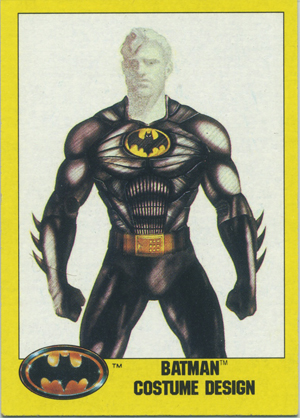
But Batman is still a man of action, even after casting Keaton over the “actors who were more the fan image of Batman” that Burton says he also considered. He takes advantage of his technological superiority over foes, so many of the action bits involve dropping in or flying away with his grappling hook, ziplining, deflecting bullets with his armor. There’s a chase in the Batmobile (an astonishing creation by Furst that we take for granted now) and another scene where he drives into Axis chemical and attacks with machine guns and bombs. But his tech fails him when his bat-symbol-shaped aircraft the Batwing, which must’ve cost him millions of dollars, gets shot down by the Joker’s novelty-sized handgun.
But, as is traditional, he seems to have elite fight training too. He scuffles with muggers, kicks a gun out of Jack Napier’s hand, there’s an alley fight with Joker goons including a brief but cool clash using his forearms and feet against a guy with two swords (Master Sken). Making his way to the Joker at the top of the bell tower he has to battle through a few different martial artist henchmen, including a gratuitous handspring guy with knives on his feet (Philip Tan, SHOWDOWN IN LITTLE TOKYO, BLOODSPORT II) who he fells with one punch like that joke where Indy shoots the hot shot swordsman in RAIDERS OF THE LOST ARK.
And what is this brief sequence:
…if not a riff on this sort of thing:
?
That little suit-up montage might be the most traditionally ’80s action bit in the movie. And you know what makes alot of sense about that? The second unit director was Peter MacDonald, the director of RAMBO III. (IMDb also says he did uncredited second unit on RAMBO: FIRST BLOOD PART II, so it’s possible he shot both Batman’s and Rambo’s gearing up scenes.)
(Unrelated, but weird: the year after BATMAN, MacDonald was an executive producer on Prince’s GRAFFITI BRIDGE.)
From what I’ve read it sounds like MacDonald shot most of the fight footage. The stunt coordinator was Eddie Stacey, who also did summer of ’89’s RED SCORPION. Batman stunt doubles were Sean McCabe and David Lea, who, in an interview with Batman Online, described Batman’s approach to fighting thusly: “Batman doesn’t have time to do spinning kicks and have a fight with you unless you’re the main guy. So if you take a punch of him you go down and you don’t get up… Batman’s on the move – he doesn’t stop. He doesn’t stop to introduce himself. He’s just bang, crash and on the move.”
 The movie did that too. Bang, crash and on the move into the ’90s, kicking off that decade’s wave of stylized comic book movies (see my article on Polygon for my takes on almost all of them) that filled up many of those summer movie slots once reserved for straightforward buddy cop movies and shit. For example in 1990 there was DICK TRACY, where Warren Beatty does indeed punch some guys and get shot at, but you’re watching more for its stunning five color production design and cartoonish special FX makeup. And the next summer there was THE ROCKETEER and the next BATMAN RETURNS and soon THE SHADOW. There were even movies starring accomplished martial arts actors (THE CROW and SPAWN) that put more emphasis on mood and production design than the physical execution of their many scenes of violence. It was a movie era more for artists than for bodybuilders, and BATMAN was the cause.
The movie did that too. Bang, crash and on the move into the ’90s, kicking off that decade’s wave of stylized comic book movies (see my article on Polygon for my takes on almost all of them) that filled up many of those summer movie slots once reserved for straightforward buddy cop movies and shit. For example in 1990 there was DICK TRACY, where Warren Beatty does indeed punch some guys and get shot at, but you’re watching more for its stunning five color production design and cartoonish special FX makeup. And the next summer there was THE ROCKETEER and the next BATMAN RETURNS and soon THE SHADOW. There were even movies starring accomplished martial arts actors (THE CROW and SPAWN) that put more emphasis on mood and production design than the physical execution of their many scenes of violence. It was a movie era more for artists than for bodybuilders, and BATMAN was the cause.
There have been better comic book movies. There have been better Batman movies. Even a better Tim Burton Batman movie. But there’s still nothing quite like BATMAN – as a movie, as a phenomenon, as a feeling.
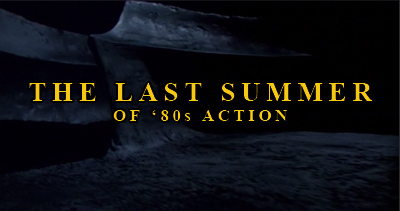
Legacy:
I mean, I think I made my argument for BATMAN’s biggest influence above. But the movie was followed by one Tim Burton sequel, two Joel Schumacher sort of sequels, and reboots by Christopher Nolan, Zack Snyder and soon Matt Reeves.
Warner Brothers capitalized on the BATMAN phenomenon by producing the groundbreaking Batman: The Animated Series. It borrowed Elfman’s theme and seemed to take inspiration from Furst and Burton’s timeless dark deco Gotham. Elfman’s conductor, Shirley Walker, composed much of the regular score as well as the theme that eventually replaced Elfman’s.
It took many years for another DC Comics character to be translated into a movie without causing embarrassment. Burton and Peters couldn’t even get a Superman movie off the ground. But in 1990 they at least pulled off a TV series of The Flash. He wore rubber muscles much like this Batman, and the theme song was by Elfman.
P.S. Believe it or not this is the restrained version where I stopped myself from going into everything I find interesting about this movie. But I want to mention this one random thing because I can’t remember anyone else ever talking about it: the very first time we see Batman in this movie he’s hand drawn animation. It’s an overhead shot of his cape and shadow, not at all photorealistic. I always thought that was a cool Burton touch, and 30 years later it’s even odder than it was then.
* * *
PROGRAMMING NOTE: I need a little recuperation and catch up time after doing Steve Wang Week, Mark Dacascos Week, Highlanderland and this first stretch of The Last Summer of ’80s Action all in a row, so I will be having an intermission – some catch up reviews and possibly some off days – before returning to 1989 for something called “Karate Kids number 3.” Thanks friends!





























June 21st, 2019 at 10:17 am
A group of friends and I would hit a big multiplex every Friday and I usually volunteered to grab the tickets and hold a place in line. Each week there’d be friends of friends or other people, and while Lethal Weapon 2 drew a big crowd Batman was the monster that summer. We had nearly 50 people in our party and I was first in line, something the rest of the crowd didn’t appreciate as more of our group arrived and pushed the line back lol
Great movie, loved the performances. Elfman’s score really sets the mood but my favorite of his will always be the jaunty one from Midnight Run. Wuhl will always be the guy he played in The Hollywood Knights to me so his sad sack goofball was a little tonally off but otherwise Burton really got the best out of his actors.